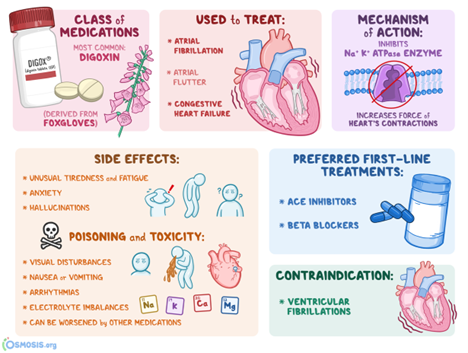Medications and Therapies
- The medications and therapies used for CCF are based on the type, etiology, and severity of heart failure. Some common medications and therapies are :
- ACE inhibitors or ARBs reduce afterload, preload, and neurohormonal activation, and prevent ventricular remodeling. Examples are captopril, enalapril, lisinopril, losartan, valsartan, and candesartan.
- ARNIs enhance the effects of ACE inhibitors or ARBs by inhibiting neprilysin, an enzyme that degrades natriuretic peptides. An example is sacubitril/valsartan.
- Beta-blockers to reduce heart rate, blood pressure, and myocardial oxygen demand, and to prevent ventricular remodeling. Examples are metoprolol, carvedilol, and bisoprolol.
- MRAs to reduce fluid retention, blood pressure, and neurohormonal activation, and to prevent ventricular remodeling. Examples are spironolactone and eplerenone.
- Diuretics to reduce fluid overload, edema, and pulmonary congestion. Examples are furosemide, bumetanide, torsemide, hydrochlorothiazide, and metolazone.
- Digoxin increases the contractility and stroke volume of the heart and decreases the heart rate and conduction velocity. It also has a positive inotropic effect and a negative chronotropic effect.
- Nitrates dilate the veins and arteries, reducing preload and afterload. Examples are nitroglycerin, isosorbide dinitrate, and isosorbide mononitrate.
- Hydralazine dilates the arteries, reducing afterload. It is often combined with nitrates for patients who cannot tolerate ACE inhibitors or ARBs.
- Ivabradine lowers the heart rate by inhibiting the sinoatrial node pacemaker. It is used for patients with HFrEF who have a resting heart rate greater than 70 beats per minute despite optimal medical therapy.
- Sacubitril/valsartan lowers blood pressure by inhibiting neprilysin and blocking angiotensin II receptors. It is used for patients with HFrEF who have NYHA class IIIV symptoms despite optimal medical therapy.
- CRT to synchronize the contraction of the right and left ventricles using a biventricular pacemaker. It is used for patients with HFrEF who have a QRS duration greater than 120 milliseconds and NYHA class IIIV symptoms despite optimal medical therapy.
- ICD to monitor the heart rhythm and deliver electrical shocks if needed to correct life-threatening arrhythmias. It is used for patients with HFrEF who have an EF of less than or equal to 35% and are at high risk of sudden cardiac death.
- VAD assists the pumping function of the ventricle using a mechanical device that is implanted in the chest or abdomen. It is used for patients with end-stage or refractory heart failure who are awaiting heart transplantation or as a destination therapy.
- IABP to increase the coronary perfusion pressure and decrease the afterload using a balloon catheter.

Nursing Test Bank
Naxlex Comprehensive Predictor Exams
Questions on Medications and Therapies
Correct Answer is C
Explanation
Correct Answer is A
Explanation
Correct Answer is C
Explanation
Correct Answer is B
Explanation
Correct Answer is C
Explanation
Correct Answer is B
Explanation
Correct Answer is A
Explanation
Correct Answer is D
Explanation
Correct Answer is C
Explanation
Correct Answer is D
Explanation
Correct Answer is B
Explanation
Correct Answer is C
Explanation
Correct Answer is B
Explanation
Correct Answer is D
Explanation
Correct Answer is D
Explanation
Correct Answer is C
Explanation
Correct Answer is C
Explanation
Correct Answer is C
Explanation
Search Here
Related Topics
- Enteral nutrition (EN) - Blood and Cardiovascular Disorders
- Mobility devices: crutches, canes, continuous passive ROM machine. - Blood and Cardiovascular Disorders
- Bandaging - Blood and Cardiovascular Disorders
- IV insertion - Blood and Cardiovascular Disorders
- Immunodefeciency disorders - Blood and Cardiovascular Disorders
More on Nursing
Free Nursing Study Materials
Access to all study guides and practice questions for nursing for free.
- Free Nursing Study Trials
- Free Nursing Video tutorials
- Free Nursing Practice Tests
- Free Exam and Study Modes
- Free Nursing Revision Quizlets
